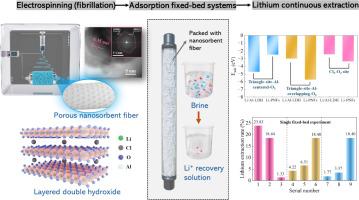在固定床系统中使用自行设计的多孔纳米吸附纤维增强连续锂萃取:优化与机理研究
IF 8.3
1区 工程技术
Q1 ENGINEERING, CHEMICAL
引用次数: 0
摘要
本研究介绍了一种新型锂/铝层状双氢氧化物(Li/Al-LDH)纳米吸附纤维(Li-PNF),该纤维可用于固定床系统从盐水中连续提取锂。这些纤维具有三维相互连接的网状结构,并被针状的锂/铝-层状双氢氧化物所包裹,呈现出逐层结构。与传统的 Li/Al-LDH 相比,Li-PNFs 具有丰富的介孔结构和更大的平均孔径,有利于 Li+ 离子的传质和分子扩散。Li-PNFs 的静态锂吸附容量约为 13.0 mg/g,对 Na+ 和 K+ 具有显著的选择性。此外,Li-PNFs 原子结构中三个不同位点的 Li+ 结合能证明了其优势,特别是在三角位点-Al-重叠-O3,达到了 -5.72 eV。固定床吸附实验证实,较低的进料流速、较高的初始锂浓度和较高的床层高度可显著提高 Li+ 捕获效率,在单个固定床实验中最高可达 23.83%。根据使用四种经验模型预测的吸附渗透曲线,发现 Clark 和 Thomas 模型可以准确预测 Li+ 在床层中的渗透行为。固定床解吸结果表明,在进料速率较低、解吸溶液中锂浓度较低和温度较高的情况下,锂的回收率最佳。最后,Li-PNF 优异的循环吸附/解吸性能和较低的制备成本进一步凸显了其在实际工业应用中的潜力,为锂萃取技术领域带来了重大进展。本文章由计算机程序翻译,如有差异,请以英文原文为准。

Enhanced continuous lithium extraction using self-designed porous nanosorbent fibers in a fixed-bed system: Optimization and mechanistic insights
This study introduced a novel lithium/aluminum layered double hydroxide (Li/Al-LDH) nanosorbent fiber (Li-PNF) engineered for continuous lithium extraction from brine using a fixed-bed system. These fibers featured a three-dimensional interconnected mesh structure and were distinctively encapsulated with needle-like Li/Al-LDH, exhibiting a layer-by-layer configuration. Compared to conventional Li/Al-LDH, Li-PNFs demonstrated abundant mesoporous structure and larger average pore size, facilitating the mass transfer and molecular diffusion of Li+ ions. Li-PNFs possessed a static lithium adsorption capacity of approximately 13.0 mg/g, with notable selectivity against Na+ and K+. Additionally, the Li+ binding energy across three distinct sites within the atomic structure of Li-PNFs proved advantageous, particularly at the Triangle-site-Al-overlapping-O3, which reached −5.72 eV. Fixed-bed adsorption experiments confirmed that lower feed flow rates, higher initial lithium concentrations, and increased bed heights significantly enhanced the Li+ capture efficiency, achieving up to 23.83 % in a single fixed-bed experiment. Based on the prediction of adsorption penetration curves using four empirical models, it was found that the Clark and Thomas models could accurately predict the behavior of Li+ penetration through the bed. Fixed-bed desorption results indicated that optimal lithium recovery was achieved at lower feed rates, reduced lithium concentrations in the desorption solution, and elevated temperatures. Finally, the excellent cyclic adsorption/desorption performance and low preparation cost of Li-PNF further highlighted its potential for real industrial applications, offering a significant advancement in the field of lithium extraction technology.
求助全文
通过发布文献求助,成功后即可免费获取论文全文。
去求助
来源期刊

Desalination
工程技术-工程:化工
CiteScore
14.60
自引率
20.20%
发文量
619
审稿时长
41 days
期刊介绍:
Desalination is a scholarly journal that focuses on the field of desalination materials, processes, and associated technologies. It encompasses a wide range of disciplines and aims to publish exceptional papers in this area.
The journal invites submissions that explicitly revolve around water desalting and its applications to various sources such as seawater, groundwater, and wastewater. It particularly encourages research on diverse desalination methods including thermal, membrane, sorption, and hybrid processes.
By providing a platform for innovative studies, Desalination aims to advance the understanding and development of desalination technologies, promoting sustainable solutions for water scarcity challenges.
 求助内容:
求助内容: 应助结果提醒方式:
应助结果提醒方式:


